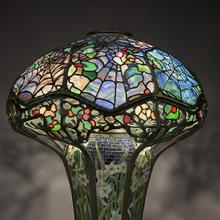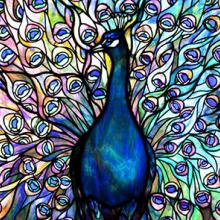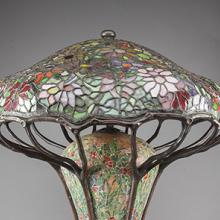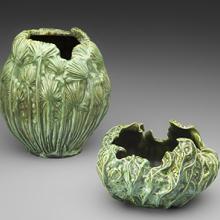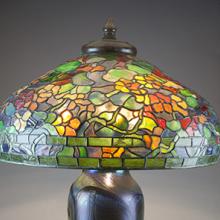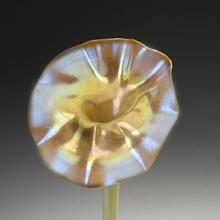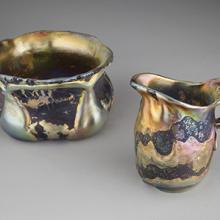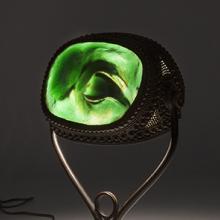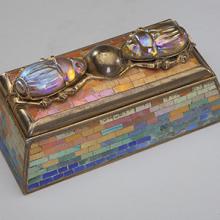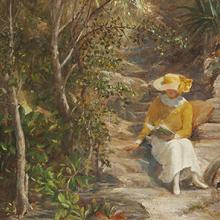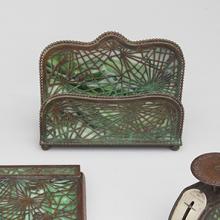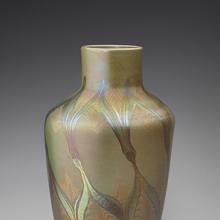International Terminal











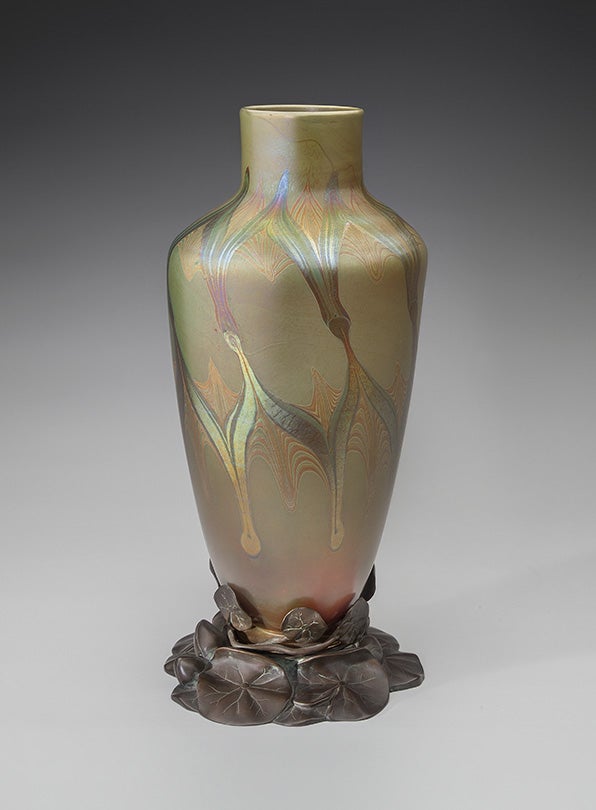
Cobweb table lamp c. 1906
Tiffany Studios
New York
glass, metal
Courtesy of Michaan’s Auctions, Alameda, CA
01A
L2014.1001.001a,b
Exoticism in Tiffany’s Designs
During the late nineteenth century, western decorative arts commonly displayed exoticism or the use of novel forms and images. Designers incorporated imagery drawn from Japan, China, North Africa, Assyria (Iraq), and Persia (Iran) into a variety of objects from ceramics to furnishings. Tiffany had a special interest in the arts of Persia and North Africa, although he also acquired Japanese and Chinese decorative objects.
Spiders and cobwebs frequently appeared in Japanese art. Tiffany, perhaps inspired by such imagery, designed a spiderweb and floral wallpaper in the early 1880s. This spiderweb or Cobweb lamp, most likely designed by Clara Driscoll, Tiffany’s leading female designer, was introduced around 1900. The original spiderweb lamp was made for combustion fuels with a canister contained in its baluster base. The designer cleverly disguised this by embellishing the base with a floral mosaic pattern. The lamp retained its mosaic base when it was later modified for electrification. Since its inception, the Cobweb lamp targeted Tiffany’s wealthiest clients with a retail price of $500 in 1906. Today, the exquisitely crafted piece remains among the most desirable Tiffany lamp models.
Peacock panel c. 1910–15
Tiffany Studios
New York
glass, metal
Courtesy of Michaan’s Auctions, Alameda, CA
03A
L2014.1001.028
Ornamental and Figural Windows
Tiffany once proclaimed, “If there is any one art which . . . has the stamp of American genius, it is that of making ornamental and figural windows in colored glass.” True to his word, of all of Tiffany’s artistic endeavors, his leaded-glass brought him the greatest recognition and was unlike anything produced in Europe at the time. During the nearly fifty years that he worked in the medium of glass, his firm became the leading supplier of leaded-glass windows. They produced thousands of windows for houses, libraries, department stores, theaters, churches, and other public buildings throughout North America. His window panels were also installed in Europe and Australia.
Tiffany hired the very best known experts, from glass blowers to chemists, drawn from both Italy and England in order to develop the colors and textures he envisioned. By 1895, he had created all of the glass varieties he desired and no longer needed to purchase sheet glass. By 1898, the Tiffany Glass and Decorating Company stored two to three hundred tons of glass in the basement of its Corona plant, classified into approximately five thousand different colors and varieties. The vast assortment of glass ranged from crystal clear to iridescent and opaque.
Zinnia table lamp c. 1910
Tiffany Studios
New York
glass, bronze
Courtesy of Michaan’s Auctions, Alameda, CA
11A
L2014.1001.058a,b
Tiffany’s Illumination
Thomas Edison revolutionized lighting with the invention of the incandescent light bulb—a technological wonder—in 1879. Tiffany softened electricity’s harsh light when he began making lamps with elegant glass lampshades in 1898. The lampshade covered the bulb and directed the light downward. Tiffany truly elevated the household lamp into an extraordinary art form—both practical and beautiful. He was among the first to recognize the potential of electrical light in the field of decorative arts.
Peak production of Tiffany lamps occurred between 1900 and 1914, although production continued into the 1920s. Tiffany produced table lamps, chandeliers, wall sconces, and floor lamps. Artisans produced floral themes in brilliant shades of red, purple, blue, orange, and yellow. Many of Tiffany’s lamp designs were adaptations of motifs from Tiffany’s windows, such as flowers, fruits, blossoming vines, and trees. With few exceptions, the bases, which were manufactured in numerous styles and sizes, were interchangeable with the leaded-glass shades.
Queen Anne’s lace vase 1905–17Tiffany StudiosNew Yorkceramic, glazeCourtesy of Michaan’s Auctions, Alameda, CA19CL2014.1001.010Cabbage leaf bowl 1905–17Tiffany StudiosNew Yorkceramic, glazeCourtesy of Michaan’s Auctions, Alameda, CA19AL2014.1001.008
Fine Ceramics
A few years after Tiffany mastered enameling, he began to produce ceramics. His inspiration came from French examples he saw at the 1900 Paris World’s Fair (Exposition Universelle). Chinese and Japanese ceramics also influenced Tiffany, after the 1876 Centennial Exhibition in Philadelphia ignited a passion for oriental design in the United States. In 1904, Tiffany debuted his Favrile pottery at the Saint Louis Exposition.
Tiffany Studios only produced about two thousand pieces of ceramics over the course of approximately ten years. Perhaps because the public readily associated Tiffany with glass, his ceramics, although exemplary, trailed behind other departments in sales. The ceramics were cast in molds made from hand-formed models and finished by hand. Tiffany often used his enamel pieces as molds for ceramics. Molds were also made from living models, such as wildflowers and vegetables, which were sprayed with shellac until rigid and then electroplated with copper. These were then made into plaster of Paris molds in which the clay was pressed into its final form. Earthy green glazes in a range of hues were favored, many of which resembled the colors of moss and lichen. Another cream-colored glaze tinged with ochre gave the appearance of antique ivory.
Nasturtium table lamp c. 1906
Tiffany Studios
New York
glass, metal
Courtesy of Michaan’s Auctions, Alameda, CA
10A
L2014.1001.002a,b
Clara Driscoll’s Designs for Tiffany
Tiffany employed hundreds of artists and craftspeople. In 1892, Tiffany established the Women’s Glass Cutting Department. For the first time, this allowed women to cut and select glass for windows, lamps, and mosaics. Tiffany truly believed that women would ensure the highest quality of artistry in his creations. Clara Driscoll (1861–1944) supervised the department, which was primarily responsible for the design and production of lampshades. Driscoll first managed a small group of six women, but by 1894, she managed thirty-five workers. Driscoll personally designed many of the lampshades. As with many of the objects produced in Tiffany’s studios, artists designed objects under his guidelines, taking inspiration from natural forms such as flowers in bloom. Although Tiffany left the design of most of the lamps and their bases to the artists working for him, he regularly inspected work in progress as recorded by Driscoll in various letters.
Jack-in-the-pulpit vase c. 1900
Tiffany Glass and Decorating Company or Tiffany Studios
New York
glass
Courtesy of Michaan’s Auctions, Alameda, CA
09E
L2014.1001.007
Art Glass
Concepts for Tiffany’s art glass came from a variety of sources; however, nature served as his greatest source of inspiration. Tiffany and his artisans studied plants, flowers, rocks, and the flow of lava. Artisans incorporated this imagery into a variety of decorative items. Tiffany’s vases in the shape of flowers are among his most fanciful creations. Some of the first examples were slender bud-like glasses, to which he added stems and leaves. Tiffany also drew inspiration from antiquity for the shapes of his vessels. Ancient Roman, Syrian, and Egyptian glass, as well as sixteenth-century Venetian glass, influenced his creations.
Tiffany glass was created in a variety of ways. Some glass pieces were cast in molds. Other types were rolled out onto a flat surface and manipulated. Artisans used blowpipes to create blown glass; molten glass was gathered at the end of the long pipe and blown like a bubble into a particular shape.
Lava bowl and ewer c. 1905
Tiffany Studios
New York
glass
Courtesy of Michaan’s Auctions, Alameda, CA
12D
L2014.1001.055, .056
Tiffany in Europe
During the 1890s, Tiffany was one of the first American designers to receive international acclaim. European art had historically influenced America; now, for the first time, artists such as Tiffany were inspiring European artists. Many of the works shown in Europe consisted of smaller pieces such as vases that could easily travel across the Atlantic. Europeans admired the quality of Tiffany glass and the innovative techniques required to produce the pieces. By the turn of the nineteenth century, over thirty European museums had acquired works by Tiffany.
The renowned Parisian gallery owner Siegfried Bing promoted Tiffany’s work in Paris and throughout Europe. Bing was an influential art dealer who helped introduce Japanese artworks to the West. In the late nineteenth century, he nurtured Art Nouveau, a new, modern style of visual arts and architecture inspired by nature, through his gallery in Paris, the Maison de l’Art Nouveau. Tiffany reached the height of his fame in Europe at the Paris World’s Fair (Exposition Universelle) in 1900 where he showcased his work in Bing’s pavilion, at his own display, and at Tiffany & Co.’s pavilion.
Turtleback desk lamp c. 1905
Tiffany Studios
New York
metal, glass
Courtesy of Michaan’s Auctions, Alameda, CA
17A
L2014.1001.083
Tiffany’s Legacy
Over the years, Tiffany operated his companies under various names, including the Tiffany Glass and Decorating Company, established in 1892 in Queens, New York. In 1902, the firm became Tiffany Studios and moved to Manhattan where it remained in operation until 1932. Tiffany also formed the Stourbridge Glass Company in 1893 as a separate glass production business, renamed Tiffany Furnaces in 1902. His father died the same year, and Tiffany became the art director of Tiffany & Co.
A few years before his retirement, in 1916, Tiffany held a masquerade at Tiffany Studios entitled “The Quest of Beauty” to celebrate his sixty-eighth birthday and to show a retrospective exhibition of his works. When Louis C. Tiffany died in 1933, the New York Times obituary proclaimed that he was “among the best known of American artists.” Despite the tremendous success of Tiffany’s many endeavors over his long career, the decorative arts of Louis C. Tiffany declined in popularity during the Great Depression and later with the advent of modernism. During the mid-1900s, collectors began to take a newfound interest in the works of Tiffany. Today, he continues to be lauded for his unparalleled significance in the field of American glass and decorative arts.
Scarab mosaic stamp box c. 1910
Tiffany Studios
New York
metal, glass
Courtesy of Michaan’s Auctions, Alameda, CA
05C
L2014.1001.062
Mosaics
Tiffany adapted his colored-glass innovations to the medium of mosaics. He once attributed his inspiration for mosaics to the dazzling interiors of the Byzantine churches he had visited as a young man. Tiffany’s magnificent glass mosaics were placed in a variety of architectural interiors from churches to libraries, department stores, and museums, on walls, ceilings, columns, and other decorative surfaces. Mosaics also appeared on novel settings, such as this stamp box.
Sarah Reading in the Grotto, Miami c. 1925
Louis Comfort Tiffany (1848–1933)
Miami
oil on canvas
Courtesy of Michaan’s Auctions, Alameda, CA
18A
L2014.1001.031
Louis C. Tiffany’s Paintings
Although Louis Comfort Tiffany’s name is most often associated with his work in the medium of glass, he first established himself as a painter and continued to paint throughout his lifetime. In 1918, at his Laurelton Hall estate in Long Island, New York, Tiffany created the Louis Comfort Tiffany Foundation, which included a school to support and encourage young artists. Fellows painted surrounded by the beauty of the artist’s country gardens. Tiffany’s extraordinary estate of nearly 600 acres was his true masterpiece. Although no longer extant, the home and meticulously landscaped gardens once served as Tiffany’s personal museum and testament to his artistic legacy.
This painting was completed during the artist’s retirement in the 1920s when he spent an increasing amount of time at his winter residence, Comfort Lodge in Miami. During this period, Sarah Hanley (1883–1958) served as the subject for many of Tiffany’s paintings. She was hired as a nurse to attend to Tiffany in his sixties. Tiffany, who was twice married previously, lost both of his wives due to illness. Miss Hanley stayed on at Laurelton Hall as his companion, protégé, and art student. After his death in 1933, she remained in the house he had built for her on his estate in New York until she died in 1958.
Pine needle desk set items c. 1902–20s
Tiffany Studios
New York
bronze, glass
Courtesy of Michaan’s Auctions, Alameda, CA
15E
L2014.1001.063; .075; 077, .091
Fancy Goods
In 1897, Tiffany acquired a bronze foundry. In addition to lamps and candlesticks, Tiffany Studios offered a variety of metalwork “fancy goods” in hammered or spun copper and cast bronze. These items, such as desk sets, picture frames, and inkwells typically incorporated subtle glass elements. Fancy goods, though produced in fairly large numbers, were fabricated with great care. Tiffany’s metalwork received international exposure when a selection was shown at London’s Grafton Galleries in 1899.
Lily pad vase c. 1900
Tiffany Glass and Decorating Company or Tiffany Studios
New York
glass, bronze
02A
L2014.1001.048
Tiffany & Co.’s Influence on Louis C. Tiffany
Louis C. Tiffany had the privilege of coming from a prominent American family as a result of his father’s highly acclaimed, luxury goods business, Tiffany & Co. Charles L. Tiffany transformed a small dry goods and stationery store in New York into one of the most famous jewelry and silverware retail operations, with branches in London and Paris. Charles Tiffany’s store and workshops helped nurture his son’s interest in the arts. The firm achieved international recognition at the 1867 World’s Fair in Paris (Exposition Universelle), when they received the grand prize for silver craftsmanship. By the 1870s, Tiffany & Co. also offered a variety of imported and American-made luxury goods, from porcelain to crystal vases and clocks.
At the Chicago’s World Fair of 1893, Tiffany exhibited his work beside his father’s Tiffany & Co. pavilion, which was lauded for displaying “the most extraordinary collection of jewels ever produced by an American jewelry house.” Even so, Louis C. Tiffany’s displays of glass in Chicago rivaled his father’s in opulence.
